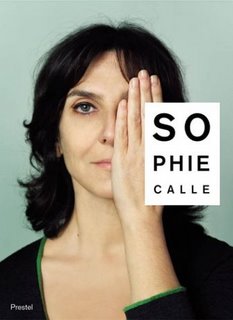
L'Erouv de Jerusalem (Installation)
27 Sept 2006
Musée d'art et d'histoire du Judaïsme
Hôtel de Saint-Aignan
Photo Credit: Sophie Calle
One of the most important and interesting figures of French contemporary art scene is Sophie Calle (b.9 oct 1953). Had seen the records and descriptions of her amazing works before but today was the first time I saw a real work of Calle, L'Erouv de Jerusalem.
Like her usual work, she plays with the ideas of memory and absence, privacy and public, intimate and voilence. In the installation, Calle asked the residents in Jerusalem to bring an object of their sweetest / bitterest memory to a public place during the Shabbat (a religious period when private and public domain is separated, i.e. no one and nothing can leave the house), and she photographied them with journals affixed to each personal memory.

Sophie Calle is the detective of urban life. In most of her works, she plays with the strangers from the streets, she is the writer, dirctor, actress and producer at the same time. She is a highly alert and inventive artist, the slightest flash or the most insignificant objects in life would become her inspiration. If you find the film Amelie Poulain (2003) amazing, you would find her work even more wonderful.
In Filatures Parisiennes (1978-80), she followed strangers in the street just like the 19th Century flaneur, she noted down their way and movements, and took photographical record of their activities, "not that I am interested in them, but just for the pleasure of following". In 1980, she followed a man all the way from Paris to Venice during 4 days, and this becomes the famous work, Suite Vénitienne (1980).

L'Hôtel (1981), she found a temporary job in a Venice hotel as a cleaner for 3 weeks. During the work, she observes and takes photos of the personal affairs, the rubbish bins, the left-over food, etc. of the hotel guests, and reconstructs their relationships, their life and their thinking.
Le Carnet d'adresses (1983), this is a very classic work of Sophie Calle. One day, she found by accident an address book in the street. She then contacted and met the strangers in the address book one by one with the aim to "reconstruct" the owner of the address book. At the end, an exhibition was organized, but it was finally closed down due to the objection of subject of the exhibition -- the address book owner!
Les Dormeurs (1980s), 24 persons were asked to sleep in her own bed in succession during 8 days, they came alone or with their lovers, slept quietly or talked before sleep, or dreamt a lot... Sophie Calle photographied their gestures every hour. One time, a sleeper didn't show up, so she had to be one of the sleepers herself.
Voyage en Californie (2003), the story of sleepers continues. In June 1999, an american boy called Josh Greene wrote to Calle asking if he could come to sleep in her bed in order to cure his broken heart. Afraid of an intrigue, she sent the bed with bedsheet and pillows to the boy in California. In Feb 2000, the boy sent the bed back to her when he was recovered.
 Damien Hirst (2003), Sophie Calle met Damien Hirst in 1989 in Glasgow. That evening of their first encounter, she asked him to write her a love letter. Later, she received a 5-page love letter from him, "a burning heart for a stranger". A year later, Calle wanted to interview Damien Hirst for her exhibition catalogue. However, she was too busy to do the interview that she asked him to makeup the questions that he imagined she would have asked him. The fictional interview was published. 12 years later, they reversed the roles, Sophie Calle asked Damien Hirst to interview her instead and he sent her a psychological test questionnaire for her and her family, the questionnaire with answers and test results were exhibited to the public in 2003 in Centre Pompidou.
Damien Hirst (2003), Sophie Calle met Damien Hirst in 1989 in Glasgow. That evening of their first encounter, she asked him to write her a love letter. Later, she received a 5-page love letter from him, "a burning heart for a stranger". A year later, Calle wanted to interview Damien Hirst for her exhibition catalogue. However, she was too busy to do the interview that she asked him to makeup the questions that he imagined she would have asked him. The fictional interview was published. 12 years later, they reversed the roles, Sophie Calle asked Damien Hirst to interview her instead and he sent her a psychological test questionnaire for her and her family, the questionnaire with answers and test results were exhibited to the public in 2003 in Centre Pompidou. Images:
1. Catalogue Cover, Sophie Calle, Centre Pompidou, 2003
2. Suite Vénitienne (1980)
3. L'Hotel (1983)
4. La Filature (avril 1981)
No comments:
Post a Comment